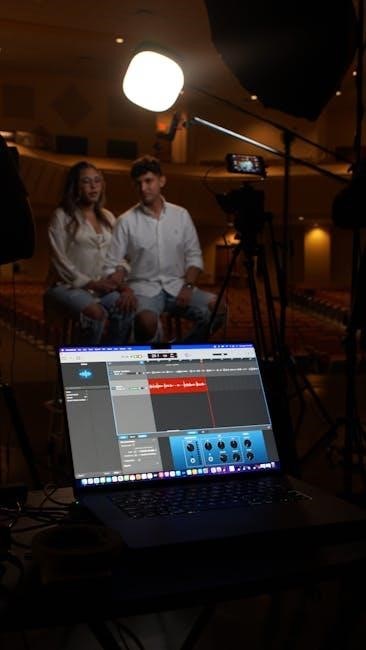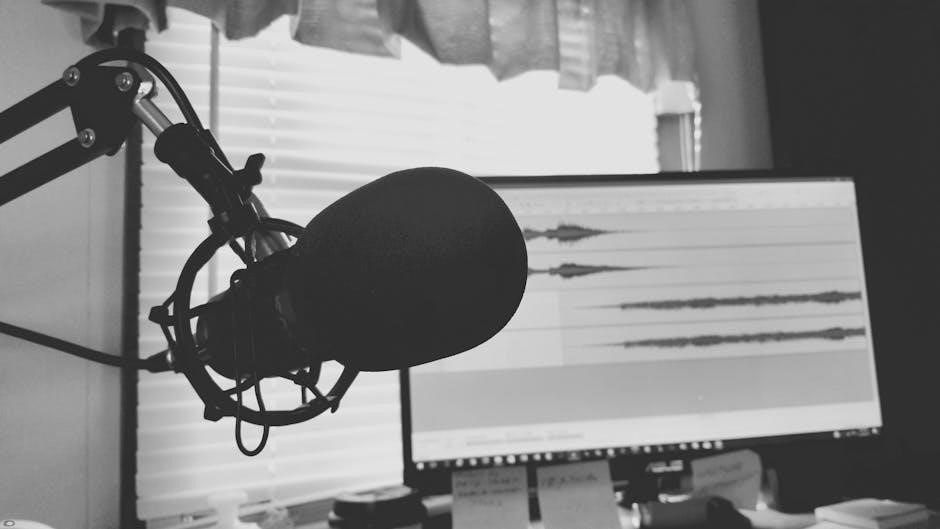The 8th edition of Sight, Sound, Motion: Applied Media Aesthetics offers a comprehensive guide to media aesthetics, now in full color with rich illustrations. It equips students to critically analyze and apply aesthetic elements like light, color, space, time-motion, and sound in media production, making it an essential resource for both learners and professionals in television and film.
Overview of the Book and Its Importance
Sight, Sound, Motion: Applied Media Aesthetics, 8th Edition is a comprehensive guide to understanding the core elements of media aesthetics, including light, color, space, time-motion, and sound. This edition is now presented in full color, enhancing its engaging and visually rich presentation. It is widely regarded as the most comprehensive book on media aesthetics, offering in-depth coverage of how these elements are creatively applied in television and film. The book is highly rated, with a 4.6-star rating from over 1,700 reviews, making it a trusted resource for students and professionals. Its availability in multiple formats, including PDF, EPUB, and MOBI, ensures accessibility for modern learners. The inclusion of a TestBank and instructor resources further underscores its importance in media education.
Key Features of the 8th Edition
The 8th edition of Sight, Sound, Motion: Applied Media Aesthetics is now presented in full color, offering a visually engaging experience. It features strong visuals inspired by traditional art forms like painting, sculpture, and dance. The book includes a TestBank and instructor resources, making it a valuable tool for educators. Available in multiple formats—PDF, EPUB, and MOBI—it caters to diverse learning preferences. The comprehensive coverage of aesthetic elements ensures a deep understanding of media production. With a 4.6-star rating from over 1,700 reviews, this edition is highly regarded for its practical insights and critical thinking exercises, making it indispensable for students and professionals in media aesthetics.
The Core Elements of Media Aesthetics

Light, color, space, time-motion, and sound are the foundational elements explored, providing a framework for understanding and applying aesthetic principles in media production effectively.

Light and Color in Media Production
Light and color are foundational elements in media production, shaping the visual and emotional impact of a scene. The 8th edition explores how light creates mood, depth, and texture, while color influences perception and storytelling. These elements guide audience attention, evoke emotions, and enhance narrative depth. The book illustrates how lighting techniques and color theory are applied in film and television to create visually compelling stories. By understanding these principles, students can harness light and color to convey meaning effectively in their productions. The full-color presentation enriches learning, offering vibrant examples that draw from traditional art forms, making complex concepts accessible and practical for media creators.
Space and Its Role in Visual Composition
Space plays a crucial role in visual composition, shaping how audiences perceive and interpret media. The 8th edition explores how space creates depth, guides viewer attention, and establishes mood. It examines the use of spatial elements like perspective, framing, and movement to enhance storytelling. The book provides in-depth analysis of how space is manipulated in film and television to create visually engaging and meaningful scenes. By understanding spatial composition, students can effectively use these techniques to communicate their narrative intent. The text is enriched with examples from traditional art forms, such as painting and sculpture, to illustrate how spatial principles are applied in media production. This comprehensive approach helps learners master the art of spatial storytelling.

Time-Motion: The Dynamics of Media

Time and motion are essential elements in media aesthetics, creating dynamic visual narratives that engage audiences. The 8th edition explores how time-motion influences storytelling through rhythm, pacing, and movement. It examines techniques like slow motion, fast motion, and montage to convey emotion and narrative intent. The book emphasizes how motion directs viewer attention and enhances visual flow. By mastering time-motion principles, creators can craft compelling sequences that captivate and communicate effectively. The text illustrates these concepts with examples from film and television, demonstrating how time-motion shapes the viewer’s experience. This section equips students with practical insights to apply time-motion dynamics in their own productions, ensuring a polished and engaging final product.
Sound: The Invisible Element in Media
Sound is a powerful yet often underappreciated element in media aesthetics, playing a crucial role in shaping the audience’s emotional and narrative experience. The 8th edition explores how sound design enhances storytelling by establishing setting, creating mood, and guiding the narrative flow. It delves into techniques such as dialogue, sound effects, and music, highlighting their impact on visual elements. The book emphasizes the importance of balancing sound with sight to create a cohesive and immersive experience. By understanding sound’s role, creators can craft engaging media that resonates deeply with viewers. This section provides practical insights into sound’s application, helping students and professionals alike to harness its potential effectively in their productions.
Application of Aesthetic Elements in Television and Film
The 8th edition explores how aesthetic elements like light, color, space, and sound are creatively applied in television and film to enhance storytelling and production quality.
Lighting Techniques in Film Production
Lighting is a crucial element in film production, shaping the visual mood and narrative depth. The 8th edition of Sight, Sound, Motion explores various lighting techniques, such as high-key, low-key, and backlighting, to create dramatic effects. It emphasizes how lighting directs audience attention, establishes tone, and enhances storytelling. Practical examples illustrate how filmmakers use lighting to evoke emotions and guide viewer focus. The book also discusses the balance between natural and artificial light, offering insights into how lighting decisions impact the overall aesthetic and storytelling process in film. By understanding these techniques, students and professionals can apply lighting strategies effectively in their own productions.
Color Theory and Its Impact on Storytelling
Color theory plays a vital role in storytelling by evoking emotions, conveying themes, and guiding audience perception. The 8th edition of Sight, Sound, Motion delves into how colors influence narrative depth, with practical examples from film and television. It explores the psychological effects of color harmony, contrast, and saturation, demonstrating how these elements enhance visual composition. The book highlights techniques like chromatic mood setting and symbolic color use, enabling creators to craft compelling stories. By understanding color’s emotional and aesthetic impact, professionals can strategically employ it to enrich their work, making it a powerful tool in media production and storytelling.
Space and Composition in Television
Space and composition are fundamental to visual storytelling in television, shaping how audiences perceive and interpret scenes. The 8th edition of Sight, Sound, Motion explores how spatial elements like depth, perspective, and framing create meaningful compositions. It discusses techniques such as rule of thirds, leading lines, and negative space to guide viewer attention. The book emphasizes how these principles enhance storytelling by establishing context, mood, and visual hierarchy. Practical examples illustrate how effective use of space can elevate production quality and engage audiences. By mastering these concepts, creators can craft visually compelling narratives that resonate with viewers, making space and composition essential tools in television production.
Sound Design and Its Role in Storytelling
Sound design is a critical yet often overlooked element in media production, playing a vital role in enhancing storytelling. The 8th edition of Sight, Sound, Motion emphasizes how sound, whether dialogue, effects, or music, creates mood, guides narrative, and immerses audiences. It explores techniques to balance audio elements for emotional impact, ensuring clarity and depth. The book highlights how sound design can subtly influence perception, making scenes more engaging and memorable. By understanding and applying these principles, creators can craft stories that resonate deeply with viewers, demonstrating the power of sound as an invisible yet indispensable storytelling tool in television and film production.

Practical Applications of Media Aesthetics

The 8th edition emphasizes applying aesthetic principles to real-world production scenarios, focusing on critical thinking and practical techniques for effective media creation, enhancing storytelling through visual and auditory elements.
Critical Thinking in Media Production
The 8th edition of Sight, Sound, Motion: Applied Media Aesthetics fosters critical thinking by encouraging readers to analyze and evaluate the aesthetic elements in media production. It provides practical examples and exercises that help students and professionals alike understand how light, color, space, time-motion, and sound contribute to storytelling. By emphasizing the importance of intentional decision-making, the book enables creators to craft visually and aurally compelling content. This approach not only enhances technical skills but also deepens the ability to communicate effectively through media. The text’s focus on real-world applications ensures that learners can apply these principles to their own projects, making it an invaluable resource for both education and professional development in the field of media aesthetics.
Real-World Examples of Aesthetic Techniques
The 8th edition of Sight, Sound, Motion: Applied Media Aesthetics provides numerous real-world examples to illustrate aesthetic techniques in media production. These examples, drawn from film and television, demonstrate how elements like lighting, color, and sound design are used to enhance storytelling. The book includes case studies that analyze specific scenes, showcasing how directors and producers apply aesthetic principles to create emotional impact. By examining these practical applications, readers gain a deeper understanding of how to implement aesthetic techniques in their own work. The text’s focus on real-world scenarios makes it an invaluable resource for both students and professionals seeking to refine their media production skills and create visually and aurally engaging content.

Downloading and Accessing the eBook
The 8th edition eBook is available in PDF, EPUB, and MOBI formats. Download from trusted sources like Amazon or educational platforms. Use a download manager for large files and ensure you have compatible eBook readers installed to access the content seamlessly.
Where to Find the 8th Edition PDF
The 8th edition PDF of Sight, Sound, Motion: Applied Media Aesthetics can be found on various online platforms. Amazon offers the eBook in multiple formats, including PDF, EPUB, and MOBI. Additionally, educational platforms like Cengage Unlimited provide access to the digital version. Users can also explore other trusted bookstores or academic websites that specialize in eBooks. For convenience, the PDF can be downloaded directly or accessed through subscription services. Ensure to use a reliable download manager for large files and verify the compatibility of your eBook reader with the chosen format. This ensures seamless access to the comprehensive guide on media aesthetics.
How to Use eBook Formats (PDF, EPUB, MOBI)
The 8th edition of Sight, Sound, Motion: Applied Media Aesthetics is available in multiple eBook formats, including PDF, EPUB, and MOBI. PDFs are ideal for retaining the book’s layout and can be opened using standard PDF readers like Adobe Acrobat. EPUB files are compatible with most eReaders and offer adjustable fonts and layouts, making them versatile for different devices. MOBI files are specifically designed for Amazon Kindle devices. To use these formats, download the file and open it in a compatible reader. For conversion between formats, online tools are available. Additionally, both PDF and EPUB files can be sent directly to Kindle or Kobo eReaders for convenient access. Ensure your device supports the chosen format for an optimal reading experience.

Additional Resources and Tools
Supplement your learning with study guides, interactive tools, and online resources that enhance understanding of media aesthetics concepts and practical applications from the textbook.
TestBank and Instructor Resources
The TestBank for Sight, Sound, Motion: Applied Media Aesthetics 8th Edition is a valuable resource for instructors, offering a wide range of test questions to assess student understanding. It provides multiple-choice, true/false, and essay questions, ensuring comprehensive coverage of key concepts. Instructors can also access additional resources, such as PowerPoint slides, lesson plans, and assignment ideas, to enhance teaching effectiveness. These tools are designed to align with the textbook’s content, making it easier to create engaging and structured courses.
With a 4.6/5 rating from over 1,700 reviews, the TestBank and instructor resources are highly regarded for their quality and relevance. They support both in-class and online learning environments, ensuring a seamless educational experience for students and educators alike.
Online Tools for Format Conversion
Online tools for format conversion are essential for managing eBooks like Sight, Sound, Motion: Applied Media Aesthetics 8th Edition. These tools allow users to convert files between formats such as PDF, EPUB, and MOBI, ensuring compatibility with various eReaders. Popular platforms offer free and user-friendly conversion services, enabling seamless access to the eBook on devices like Kindle or Kobo. Additionally, some tools support bulk conversions, ideal for managing large collections of educational materials. These resources are invaluable for students and educators, providing flexibility and convenience in accessing the book’s content across different platforms. By utilizing these tools, users can optimize their reading experience and ensure uninterrupted access to the eBook’s comprehensive insights on media aesthetics.
Impact of the Book on Media Education
The 8th edition of Sight, Sound, Motion: Applied Media Aesthetics significantly influences media education by providing a comprehensive, visually enhanced resource that fosters critical thinking and practical application of media aesthetics, benefiting both students and professionals.
Student Reviews and Feedback
Students have praised the 8th edition of Sight, Sound, Motion: Applied Media Aesthetics for its comprehensive approach and engaging presentation. With a 4.6/5 rating from over 1,700 reviews, learners appreciate its detailed coverage of media aesthetics, enhanced by full-color visuals. The book’s ability to connect traditional art forms like painting and sculpture to modern media production makes it a standout resource. Many find the practical examples and real-world applications particularly helpful for understanding complex concepts. The PDF format is also commended for its accessibility, allowing students to study across multiple devices. Overall, the text is celebrated for its clarity, depth, and effectiveness in fostering a strong understanding of media aesthetics.
The Book’s Role in Modern Media Production
Sight, Sound, Motion: Applied Media Aesthetics plays a pivotal role in modern media production by providing a comprehensive understanding of aesthetic elements. It bridges theory and practice, offering insights into how light, color, space, time-motion, and sound shape visual storytelling. Professionals and students alike rely on its practical examples and real-world applications to enhance their creative workflows. The book’s full-color visuals and traditional art references make it a versatile tool for both analog and digital media production. By equipping creators with critical thinking skills, it empowers them to innovate and refine their craft, making it an indispensable resource in the ever-evolving media landscape.

Conclusion
Sight, Sound, Motion: Applied Media Aesthetics remains a cornerstone in media education and production, offering unparalleled insights into the core elements of visual storytelling. Its comprehensive coverage of light, color, space, time-motion, and sound, combined with practical applications, makes it an indispensable resource for both students and professionals. The 8th edition’s full-color presentation and rich visuals enhance its accessibility, while its focus on critical thinking empowers creators to innovate in their craft. As a versatile tool, it bridges the gap between theory and practice, ensuring its relevance in modern media production. With its widespread availability in eBook formats and additional resources like TestBank, this book continues to shape the future of media aesthetics.



